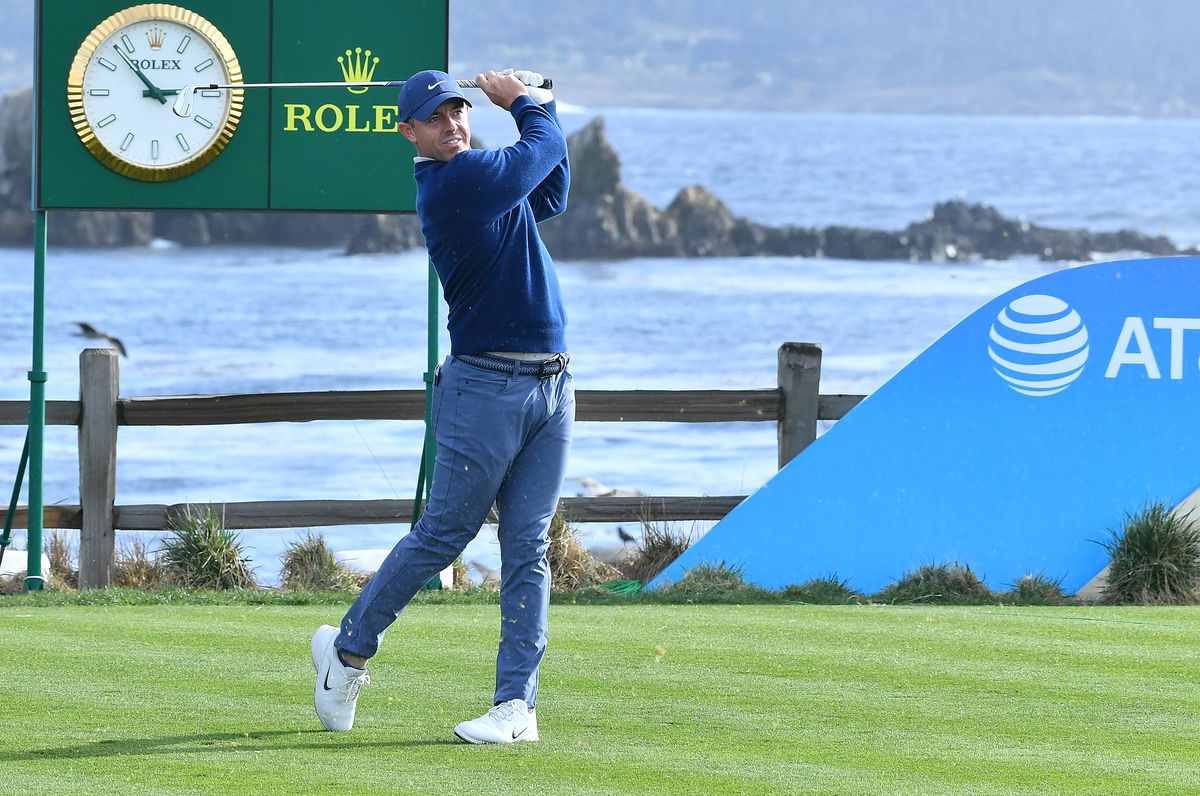
Imago
February 2, 2025, Pebble Beach, Ca, USA: Rory McIlroy is seen on the tee at hole 17 just before winning the Pro-Am on the final round of the AT&T Pebble Beach Pro-Am 2025 at Pebble Beach Golf Links on February 02, 2025 in Pebble Beach, California. Photo: Casey Flanigan/imageSPACE Pebble Beach USA – ZUMAi237 20250202_zsa_i237_119 Copyright: xFlanigan/Imagespacex

Imago
February 2, 2025, Pebble Beach, Ca, USA: Rory McIlroy is seen on the tee at hole 17 just before winning the Pro-Am on the final round of the AT&T Pebble Beach Pro-Am 2025 at Pebble Beach Golf Links on February 02, 2025 in Pebble Beach, California. Photo: Casey Flanigan/imageSPACE Pebble Beach USA – ZUMAi237 20250202_zsa_i237_119 Copyright: xFlanigan/Imagespacex
We’ve all had those days where we hit annoyingly fat chunks on the course or a thin-toe shot that gives us the icks. And it usually happens when our hands are disconnected from our body and don’t move as one unit on an arc. It’s famously called the “chicken wing” in golf. But how do you fix that? That’s where The Connector comes in — a soft but mighty training aid.
Watch What’s Trending Now!
This new training aid on the block looks very similar to the Tour Striker Smart ball, but it’s actually quite different. For starters, it’s a soft memory-foam wedge-shaped aid, and it looks like a sphere from a distance, but it’s actually not. Unlike the inflatable ball training aids, the Connector has indentations on the sides to fit your arms and has three sticks attached — two on the side to lock your arms in and one in the center to monitor your swing path and alignment.
The main aim of this aid is to help synchronize your swing better and improve power and consistency, so you get that solid contact at impact. If you’re looking to work on a swing that feels more connected, it’s time to invest in this new training aid. And once you do, these are the drills you can try to get you started on working towards a better game.
ADVERTISEMENT
Top Stories
LIV Golf Star to Play With Rory McIlroy for Career-Changing Reason, Ditching $6M Event – Insider

Who Is Nelly Korda’s Fiance, Casey Gunderson? Personal Life, Career & More Details Revealed

Brandel Chamblee Calls Out PGA Tour’s Shift Toward LIV Golf Model Following Strict Policy Changes

Phil Mickelson Laughs in Disbelief at PGA Tour Pro’s Unreal Record: ‘Can’t Fathom That’

Kai Trump Breaks Silence on Backlash Over Her 2025 The Annika Debut

#1. The 3 o’clock to 9 o’clock Swing
Set yourself up with The Connector tucked between your arms. One way to know if it’s placed correctly is to ensure the white rod sticking out in the middle is aligned with your clubface and well in the middle of your body. Make sure it’s pointing straight out and away from you.
Now, swing from 3 o’clock to 9 o’clock — think half-swing length, but full-swing intention. The goal here isn’t to smash it, but to feel the arc. Just a simple, inside-to-inside arc. No over-the-top lunges, no casting. Just smooth, synced-up motion where your arms and body feel like they’re finally in sync.
ADVERTISEMENT
Pay attention to how the center rod on The Connector moves. When you’re halfway through the swing, it should point up as you go back, and up again as you swing through. That’s your cue that your forearms are rotating correctly and the clubface is where it should be. The intent here is to understand how to work with the Connector and the body’s movement.
ADVERTISEMENT
#2. Rehearsing the Impact Position
This drill is almost an extension of the first, but the main focus here is to now focus on compressing the ball. Start by rehearsing the position you want at impact. Ideally, for irons, it’s with your hands placed as forward as possible with the clubhead staying back at impact.
And a quick checkpoint with the aid is to make sure the middle rod is pointing just slightly out front. The rehearsal should feel strong, stable, and loaded — like you’re coiled up and ready to launch.
Now, from that rehearsed spot, work backward into a soft, compact backswing, then return. Do it again. Again, the intent is not to swing as fast or as hard as you can. It is to get the movement right. You’re training your body to deliver power from the right place, every single time.
ADVERTISEMENT
So, take your usual swing with the connector placed in between your arms, but rehearse your impact position with every swing before you hit. The Connector will keep your elbows from flying out, will keep your body moving as one, and you’ll see your impact changing almost instantly.
On the range with @McIlroyRory 🧐#DPWIC pic.twitter.com/wGFuUa6jyp
— DP World Tour (@DPWorldTour) October 14, 2025
ADVERTISEMENT
#3. Basic Pitching
This training aid can also be used for your short game, and is especially very helpful in mastering your pitching technique. Very similar to the first one, the pitching drill uses shorter length swings (based on the distance), with the main intent of swinging on an orbit around your body.
Let’s break it down. Set yourself into your address position with The Connector in place. Now, let the club move gently around you, almost like it’s circling your body in a shallow loop. Visualize the ball being swept up here, different from what we were trying to achieve in the first drill, where we were trying to compress the ball. Pitch shots typically have a softer feeling, so you do not want to dig into the ground too much.
Just feel like your hands are moving in half & half motions with your lower body following, and you’ll get the effortless in-to-in movement. The Connector keeps you from snatching the club away from your body or pushing your hands too far forward. You could use the same technique for your chips or shorter pitch shots.
#4. Turning the Chest
This one’s an extension of the basic pitching drill. With The Connector snug in your arms, your structure’s set. Now forget the hands, forget the arms — just focus on turning your chest. That’s it. On the way back, rotate your torso so the center rod points slightly up. Then turn through, letting your chest lead the way again. When the torso powers the swing, everything else falls in line — no more flappy arms or the annoying chicken wing.
The Connector keeps the arms quiet and connected, so all you have to do is rotate. With this, your pitch shots feel clean, compact, and super repeatable. No overthinking, no collapsing elbows — just a solid chest turn and crisp contact. This drill is ideal for pitch shots ranging over 60 yards, because the longer shots are the ones where you use more body rotation.
#5. Putting Drill
While it’s not commonly seen with most pros, the Connector can also be used to fix your putting stroke. Just like the golf swing, the putting stroke requires us to use our body as a unit, moving almost like a pendulum with minimal wrist hinging. With The Connector in place, your arms stay glued to your torso. Set up as normal, and focus on rocking your shoulders back and through, keeping that center rod moving straight down your line. The foam keeps your stroke compact and your hands quiet, which is exactly what you want inside ten feet.
This drill is perfect for players who get a little handsy or struggle with a consistent stroke path. With your arms connected and movement driven by the shoulders, you’ll feel a smoother tempo and better face control — which means fewer pulled putts, cleaner rolls, and more of that dead-center contact.
If you’re still wondering whether this training aid is worth the hype, just know that even Rory McIlroy has been spotted grinding with it recently at the DP World India Championship. That’s right, one of the smoothest swingers in the game is using The Connector to fine-tune his swing. And if it’s good enough for McIlroy, it’s more than good enough for the rest of us. While it might be a bit pricey for some ($400+), it is definitely worth the investment.
Whether you’re pitching, putting, or just trying to tune your full-swing, these drills bring structure, feel, and connection into your swing. They will help you strike it cleaner, more consistently, and with way more confidence.
ADVERTISEMENT
ADVERTISEMENT
ADVERTISEMENT

